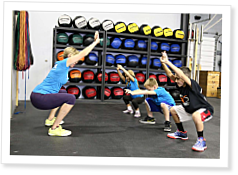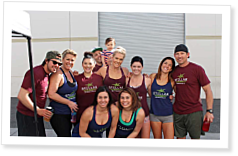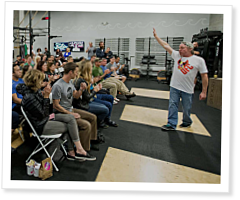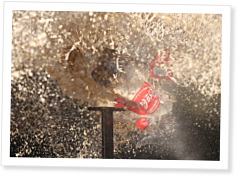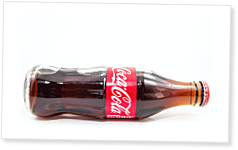by Kyle Mask
“Conventional deadlifts actually work the back and hips harder, and a mechanical analysis of the two styles will show us why this is the case.”
Read More
var addthis_config = {"data_track_addressbar":true};
Conventional deadlifts actually work the back and hips harder, and a mechanical analysis of the two styles will show us why this is the case.
First, a disclaimer: This article is not intended for the super-obese. If excessive adipose tissue prevents you from correctly setting up for the conventional deadlift, by all means pull sumo or do partials, and definitely seek out a treadmill. Neither is this article intended for the super-old or super-injured. If you’re too weak or decrepit to safely perform the full range of motion conventional deadlift, train the lifts you can safely perform.Got it? Good. Almost all of you should still be reading. Raw powerlifting is getting pretty damn popular, and this is a good thing to those of us who inherently value strength. Even federations that formerly catered to geared lifters now routinely host meets where only one or two lifters can be seen in the warmup room hanging from the monolift, attempting to shimmy into a squat suit. In fact, I competed at an SPF meet in August with thirty-five full meet lifters and not one squatted in a suit. So the tides are changing.With this nascent interest in the sport, many folks who would have remained lifetime recreational gym rats ten years ago are now stepping onto the platform. And many young lifters are getting the itch to compete after only a few short months of training exposure. These are exciting developments that bode well for the future of the sport. These developments (greatly enhanced by the interest in barbell training Crossfit has inspired, whatever else one may say about Crossfit) have resulted in many more gym goers performing the powerlifts. Naturally, these newer lifters often turn to internet resources for technical instruction on the lifts. And now I’m going to ask you to suspend disbelief for a moment and just consider that what I’m about to say might be true, alarming as it sounds: there is a lot of misinformation – even downright bullshit – on the internet. I know, crazy stuff. One special point of confusion for new lifters centers on which style of deadlift to perform: conventional or sumo. Conventional deadlifting uses a narrower stance with hands outside the legs, whereas sumo uses a wider stance with hands starting inside the legs. Powerlifters – even very experienced ones – have been largely responsible for the proliferation of much bad advice about deadlifting for novices. Of the falsehoods they spread, one of the most prevalent is that sumo deadlifts are superior to conventional for a vast number of lifters, novices included.As a result of their intensive internet research, novice and intermediate lifters routinely approach me with concerns that the conventional deadlifts they have been performing are not optimal. They need to switch to sumo because they can’t keep their backs flat conventional; or they need more hip work, which they (wrongly) think sumo will provide; or their arms are short; or they just have too tough a time recovering from conventional pulls. This article is my attempt to set the record straight on which style of deadlift (almost) everyone should be performing.Why Conventional is Superior: A Mechanical Analysis“Conventional deadlifts work the back harder, but sumo deadlifts work the hips harder.” This line of thinking is ubiquitous in the powerlifting community. At first glance it appears reasonable, after all, since the sumo deadlift looks more like a squat with the bar in the hands, and we all know the squat is king for hip development. In powerlifting circles, it often serves as a justification, whether explicit or implicit, for abandoning conventional pulls in favor of sumo. “No, Joe isn’t a pussy for switching to sumo. Sure, he won’t get as much back work, but he’ll be working his hips harder. He’ll be doing something harder.”This thinking, however, only gets it half right. Conventional deadlifts actually work the back and hips harder, and a mechanical analysis of the two styles will show us why this is the case.Let’s take the following as axiomatic for any pull off the floor, sumo or conventional: The correct starting position is one in which the barbell is mid-foot, the scapulas are directly over the bar, and the shoulders are just in front of the bar. Lifter/barbell systems assume these relationships whenever lifters break heavy barbells from the ground, and the most efficient pull will keep the bar mid-foot (i.e. in a straight line) to completion. Now, when a lifter assumes this starting position with the spine flat, his anthropometry will dictate his back angle (angle between torso and horizontal floor), hip angle (angle between torso and femur), and knee angle (angle between femur and tibia). The sumo deadlift artificially alters the lifter’s anthropometry, effectively shortening the legs. This changed anthropometry dictates different back, hip, and knee angles for the sumo deadlift. The shortened legs allow the lifter to reach down and grab the bar with his shoulders set higher than in a conventional pull, resulting in a much more vertical back angle. A more vertical back, in turn, requires a lower hip position, which closes the knee angle. The more vertical back also results in a more open hip angle. The more open hip angle is a little less intuitively evident, as the change in femur position relative to the floor in sumo (the femur becomes more horizontal) seems as if it might offset the more vertical torso, possibly resulting in a similar hip angle to the conventional deadlift. However, just as the more vertical back angle in a high bar squat produces a more open hip angle and closed knee angle than in a low bar squat, so the same relationship between the three angles exists when comparing the sumo to the conventional deadlift. Like the high bar squat, the sumo deadlift uses a more vertical back angle, open hip angle, and closed knee angle. Just to make sure, I used the Coach’s Eye App to measure the hip angle of several lifters during conventional and sumo pulls and confirmed that the hip angle is significantly more open (generally by a little less than 10 degrees) in a sumo deadlift.Before we see why all of this matters, let’s examine the concept of moment/moment arms. Then we’ll be in a position to see how the sumo style affects the relevant moment arms and leverages in the deadlift.Physics ClassMoment force is the measure of a force’s capacity to produce rotation about a pivot point, or fulcrum. Moment force is the product of two variables: (1) the quantity of force exerted at the point of force application, and (2) the length of the moment arm. Think about a wrench turning a bolt. A wrench is a rigid segment of a given length connecting the bolt to your hand. When the hand pulls on the wrench, it applies a force to the wrench (variable #1). The moment arm is the distance between the point of rotation (the bolt) and the force application (hand pulling the wrench), measured at 90 degrees to the force application (variable #2).Since moment force is the product of these two variables, it is the force applied by the hand (variable #1) multiplied by the length of the moment arm (variable #2). Given the same application of force by the hand to the wrench at a 90 degree angle to the bolt, a longer wrench produces greater moment force, and thus a stronger tendency of the bolt to rotate. All other things being equal, a shorter moment arm results in worse leverage against the bolt, while a longer moment arm results in better leverage to turn the bolt.{pagebreak}When we lift barbells, we measure moment arms perpendicular to the downward pull exerted by gravity on the barbell – that is, we measure moment arms in barbell training horizontally. The point of force application is the barbell (which should be over mid-foot), and the pivot points are our joints. So moment arms are the horizontal distances between relevant joints and the barbell/mid-foot balance point (presently we need not consider moment arms that arise when barbells are not balanced over mid-foot).It is important to realize that in barbell training we are in a position more analogous to a bolt trying to turn a wrench, since the segments of the body – the torso, femur, and tibia – lift the weight (this isn’t precisely what’s happening since our joints don’t rotate, but bear with the illustration for now). The barbell is the hand pulling down on the wrench, and we must produce enough force about the bolt to overcome this and turn the wrench. The shorter the moment arm between our joints and the barbell, the less moment force acting against us and the easier the lift. The longer the moment arm, the more force we must exert to turn the wrench rather than letting it turn us. A longer moment arm for our purposes – which, remember, is to get stronger – therefore means that we must overcome more leverage to lift a given weight.Physics Class, Applied So how does pulling sumo affect the relevant moment arms in the deadlift? By artificially decreasing femur length, the sumo deadlift allows the lifter to get his hips closer to the barbell, thereby decreasing the moment arm between hips and barbell. And as the back has become more vertical in sumo, there is a shorter moment arm along the trunk segment. Thus the hips, as well as the muscles that stabilize the torso, have less leverage to overcome as a result of these decreased moment arms.Sounds pretty good if our sole purpose is to lift the most possible weight, right? Well, maybe and maybe not. More on that later. But we are concerned with getting stronger, not with finding ways to make the deadlift easier. We can think about moment arms in two ways – pessimistically and optimistically. The pessimist wants to minimize moment arms so that the body has to overcome less leverage. The optimist, on the other hand, realizes that moment arms are tools we use to produce the stimulus to get strong. And this is where the thought process typical of sumo advocates becomes inconsistent. Proponents of the sumo deadlift readily concede that the conventional deadlift provides superior stimulus to the spinal erectors. The spinal erectors – indeed, all of the muscles that stabilize the torso – must work harder in the conventional deadlift to keep the horizontally-oriented torso flat. Imagine a long diving board with a very large, heavy diver standing on the far end. Now take that same diving board and incline it 20 degrees so that the diver is standing on the upraised end. The board will bow less than when it is horizontal. The diving board is the torso and the diver is the force applied by the barbell. The spinal erectors are what keep your back – the board – from flexing, and they must work harder the longer the horizontal distance from the fulcrum to the point of force application. So we all agree that the conventional deadlift works the spinal erectors harder.But sumo proponents also argue that sumo provides superior stimulus to the musculature responsible for extending the hips. Why, we must ask, if the increased leverage against the torso in the conventional deadlift elicits a superior stimulus for the back muscles, would not the increased leverage against the hips also elicit a superior stimulus for the muscles that extend them?Consider the two seesaws below with 400 lb barbells strapped to the long ends. These seesaws are the same in all regards except the moment arm between the fulcrum (represented below by the triangles) and the barbell is twice as long on the seesaw on the bottom. We want to lift the barbell, so we will need a downward force at the short end of each seesaw sufficient to accomplish this. Obviously, the seesaw on the bottom, with the longer moment arm between the fulcrum and the weight, will require more force at the short side to lift the barbell – twice as much force, in fact, since the moment arm on the long end has been doubled. In the deadlift, the fulcrum is the hip joint and the muscles creating the downward force at the short side of the seesaw are the hip extensors. And the hip extensors must pull harder on a longer moment arm between the hips and the barbell.
We can conclude that there is no tradeoff between back and hip work in the two styles of deadlifts, as is typically assumed to be the case. When lifters opt for sumo over conventional, they aren’t getting as much back or hip work. They’ve simply put the body in a position where it has to overcome less leverage to lift a given weight.Some of the confusion among sumo proponents might arise from a misunderstanding of the back’s role in the deadlift. Those of us who have been lifting a while have heard someone say something like, “The back does more of the lifting in conventional, whereas the hips do all of the lifting in sumo.” It is important to note that the back doesn’t “lift” anything in either style of deadlift – that is, the back muscles do not vertically displace the barbell. The torso is merely a rigid segment through which force generated by knee and hip extension is transferred down the arms to the barbell, and the back muscles keep this segment taut. Overwhelmingly, hip extension is the “motor” that lifts the weight in both styles, and we now know which style requires a stronger motor. It is further instructive to observe which style of deadlift requires the hips to work through a longer range of motion. Because the hip angle must end up completely open at lockout in both styles, the style that begins with a more closed hip angle requires the hip extensors to open the angle through a longer range of motion. As we can see from the analysis above, this is the conventional style. So not only does the barbell move a greater total distance in the conventional pull, but the muscles responsible for hip extension also work through a more complete range of motion. Given this consideration, along with the above discussion of moment arms, we now can conclude that the conventional deadlift works the hip musculature harder through a longer range of motion than the sumo deadlift.{pagebreak}This talk about moment arms and angles might all sound very familiar. Indeed, these are reasons why Mark Rippetoe, in Starting Strength: Basic Barbell Training, advocates the low bar squat over the high bar. Rip states: “we use [the low bar squat] because the more horizontal back angle, closed hip angle, and open knee angle place the hips further behind the mid-foot balance point, creating a longer moment arm we can use to involve more muscle mass and lift heavier weights” (SS:BBT, p.34). Given the above analysis of the two deadlift styles, we have made an analogous argument for the conventional deadlift over the sumo deadlift. Like the low bar squat, the conventional deadlift involves a more horizontal back angle, closed hip angle, and open knee angle than the sumo deadlift, resulting in more muscle mass utilized over a longer effective range of motion. But will the conventional deadlift result in more weight lifted? Not invariably. We must keep in mind that the shorter moment arms involved in sumo require the hips and back to overcome less leverage to lift a given weight. Due to these shorter moment arms, the shorter range of motion, and variations in individuals’ anthropometries and relative muscular strengths/weaknesses, some lifters will be able to lift more sumo. However, the simple fact that many lifters – probably most lifters – can pull more conventional lends additional support to the conclusion of the mechanical analysis above. There must be some factor that accounts for the ability of most lifters to pull more conventional despite the longer moment arm between hips and barbell and the longer range of motion involved. This factor is more muscle mass. Consider what happens to the hamstrings in the sumo deadlift. Again, the analogy between the low bar squat/conventional deadlift and the high bar squat/sumo deadlift is useful. In the same way that the more closed knee angle in the high bar squat results in a distally shortened hamstring, so the closed knee angle in a sumo deadlift distally shortens the hamstring. The more open hip angle in sumo also shortens the hamstring proximally. The result in the sumo deadlift, as in the high bar squat, is a hamstring that has been shortened before the concentric phase of the lift has even begun, meaning a hamstring that cannot contribute optimally to the hip extension about to occur. The conventional deadlift, on the other hand, like the low bar squat, makes use of an initially elongated hamstring that better contributes to hip extension than the sumo deadlift. To be fair to the sumo deadlift, the wide stance with toes pointed out probably involves the adductor musculature to a greater degree. When the external rotators do their job of keeping the knees out in the sumo deadlift, the adductors are more elongated at the start of the lift than in the conventional pull and can better contribute to hip extension. The adductors, however, are a smaller muscle group than the hamstrings. In the sumo pull, these smaller muscles are doing more of the hip extension that the larger muscles of the hamstrings are better positioned to do in the conventional pull. Because it makes sense to use a technique that calls on bigger muscles to generate stronger hip extension, the conventional deadlift is the superior choice. And even when we pull conventional we can manipulate technique in such a way as to make the adductors do a fair share of work. By turning our toes slightly out and pushing our knees out into our elbows, we increase the adductors ability to contribute to the lift. The sumo deadlift also requires the quadriceps to extend the knees over a greater range of motion. However, as Starting Strength Coach Michael Wolf astutely pointed out to me, the quadriceps and adductors already get worked over a longer range of motion in the low bar squat. And as we have seen, we can significantly involve the adductors even in a conventional pull by pointing the toes/knees out. So it’s not as if we aren’t already giving the quadriceps and adductors enough work in a properly designed strength training program.Moreover, there is virtually no moment arm between the knees and barbell in either style of deadlift. Lifters fail deadlifts because they can’t extend their hips while keeping their backs rigid, not because they can’t extend their knees. The ability to extend the hips and keep the back flat are where the rubber really hits the road in any deadlift, so it makes sense to pick the style that best develops this capacity. This style is the conventional deadlift.But I’m One of Those Who Can Pull More Sumo…So, you’ve read this far. And maybe now you even accept the argument that the conventional deadlift works more muscle mass (including hip extensors) over a longer effective range of motion than the sumo deadlift. But you’re one of those people who can pull more sumo for whatever reason. Perhaps you have a weak back that can’t stay flat under heavy loads conventional. Or perhaps you never trained the conventional deadlift seriously in the first place. Perhaps you even had early aspirations of becoming a competitive powerlifter and were told by some big, strong guy that powerlifters are better off using sumo. Whatever the reason, now you’re wondering, “Should I be pulling conventional? Should I take weight off the bar?”The answer for anyone reading this article is almost certainly a resounding “Yes.” In fact, the chances of you being an exception to the rule are so slim, let’s just drop the qualifiers and answer Yes. Starting Strength uses three criteria for selecting the lifts we use to get strong. We choose the lifts that allow us (1) to work the most muscle mass, over (2) the longest effective range of motion, with (3) the most weight possible. We’ve seen that the conventional deadlift satisfies the first two criteria. And for most lifters it will satisfy the third (independent of the first two) on account of the additional muscle mass utilized. However, even for those who can pull more sumo, it is important to realize that the criteria are ordered as they are for a reason. We don’t substitute lifts where more weight can be lifted at the expense of muscle mass worked and range of motion. Otherwise, we would be doing rack pulls and quarter squats to the exclusion of deadlifts and squats. And if you’ll actually train your conventional pull, I can almost guarantee it won’t be substantially lower than your sumo pull anyway.Naturally, there are anthropometric outliers for whom the conventional deadlift presents an insurmountable obstacle. If you set up properly for a deadlift and your shoulders are lower than your hips, sure, you probably need to pull sumo. But there aren’t many folks with the odd combination of long femurs and midget arms, so this isn’t you. I don’t care how many internet articles you’ve read about how certain anthropometries fare better sumo, or how special you believe your own body to be. The fact remains that the conventional deadlift trains the back and hips better than sumo, and therefore will make you stronger than sumo.But what about those who need to demonstrate strength rather than obtain it? What if your lone goal is to lift more in competition, and after trying both styles, you’re stronger sumo? I’m well aware that Coan sometimes pulled sumo, and that Malanichev and Green always pull sumo in competition. You should also be well aware that you’re not Coan, Malanichev, or Green. I’m not trying to tell 800 lb deadlifters what to do, because they’ve already done what they need to do. But you do need to listen, because you still need to get stronger – a lot stronger. Most of you are novice or intermediate lifters, and you need to deadlift in a way that provides the greatest stimulus to the most muscle mass over the longest range of motion. Your primary concern should be building strength, not demonstrating it. Once you’re an advanced lifter, feel free to experiment with sumo for the purpose of competition. I would submit that even those who pull sumo in competition should continue to perform some of their work in training conventional. Coan obviously did. And there are plenty of Youtube videos floating around of Green and Malanichev pulling heavy weights conventional in training. Whatever these lifters’ reasons for keeping conventional deadlifts in their programs, the additional back and hip work provided by the conventional deadlift carries over to the sumo pull. Even world class sumo pullers should (and apparently often do) continue to train the conventional deadlift.Doing the Hard ThingsConventional deadlifts are harder than sumo deadlifts. It’s harder to keep the back flat, it’s harder to extend the hips, and the bar must move a longer distance. They also hurt worse, make you sorer, and just generally leave you more fatigued. But like most things in life, doing the hard thing pays off. Conventional deadlifts produce a stronger back and hips than sumo deadlifts. And if you’ll stick with them long enough to build some strength in the back that is weak from so many years spent on the couch playing video games, you’ll probably find that you can pull more weight conventional. The next time you see a 200 lb lifter pulling 400 and some odd pounds sumo at a meet, remember that this guy has taken the easy way out, albeit perhaps unwittingly. He, and you, would be better served by committing to the deadlift style that uses a longer moment arm between hips and barbell, and a more horizontal torso segment, to produce the greatest gains in total body mass and strength. You’ll have plenty of time to consider pulling sumo for competitive reasons once you’ve established a 600-700 lb conventional deadlift. But by then, you probably won’t even care to.
Kyle Mask is a competitive powerlifter in the 198/220 pound classes with best raw (unwrapped) competition lifts of 573/402/661 in the squat, bench, and deadlift. Before taking up powerlifting, he competed in strongman, finishing 6th in the 200 pound class at nationals in 2005. One of the few Nashvillians who does not aspire to be a professional musician, he nevertheless has been known to imitate one at local karaoke dives.






